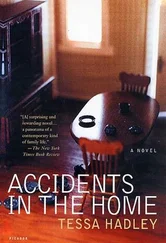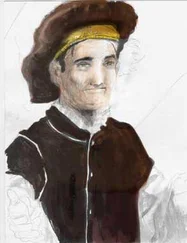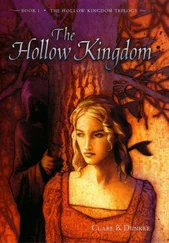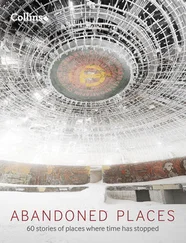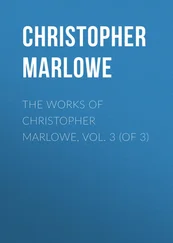What Wigram didn’t learn about the yew tree at the tithe luncheon he must have found out later through conversations with Thomas, facts he finally set down on paper in February 1888 when he wrote to the Hertfordshire Mercury , replying to D.E.’s question about Piers Shonks’ tomb. His letter concluded with the following story:
In subsequent ages the yew tree was cut down by a labourer well known to my informant, the parish clerk. The man began his work in the morning, but left it at breakfast time, and on his return found that the old tree had fallen, collapsing into a large cavity underneath its roots. That such cavities have been found in other cases under old yew trees I have been told. Whether this one was simply enlarged by the dragon for his own convenience, or whether it was wholly dug out by that creature’s claws, there is no evidence to show.
This is the earliest account of the felling of the tree. Was Wigram preserving custom or creating it? If true, it posed some fascinating questions. Was the cavity visible before the tree came down? Had it played a role in the origin of the legend, or at least in the tradition that the dragon lived under a tree in that field? Many of the written accounts said that the dragon had lived in Great Pepsells field, others said it had lived under a yew tree in the field. Had tradition always associated the dragon with that particular tree and, more to the point, had Master Lawrence known that when he set his axe to its roots?
The Variety of Wonderscaused some Suspition of the Truth of his Relations; but all things that seem improbable are not impossible, and the ignorance of the Reader does oftentimes weaken the Truth of the Author …
—Henry Chauncy, The Historical Antiquities of Hertfordshire , 1700
Folk legends, with their origins buried deep in the past, owe much to unseen forces; they are crafted gradually like limestone pillars on the seashore, eroded imperceptibly to their present shape by sea and wind and rain. For a time at least, they might resemble something recognisable: a witch’s face in profile, say, or a giant’s fist. Can we say what the rock originally looked like or what other shapes it has taken over thousands of years? Occasionally, however, it changes in a moment – when a storm sweeps away a large chunk – and the cause of the new shape can be discovered by listening to the old people or turning up the water-damaged logbook of a ship.
The shifting themes and motifs in the different versions of the Shonks legend made it clear that his story had changed many times over the centuries. Oral accounts must have morphed in the telling, and then, once people started writing them down, they could not resist dreaming up a detail or two of their own; eventually the oral tradition became a garbled version of early written accounts and vice versa. Old motifs were embellished by an eager storyteller, others borrowed, new emphases were made, traditions were misconstrued, meanings were forgotten and re-remembered back to front, small details were tacked on to add colour.
Was it possible to say where the detail t hat the dragon lived in a yew tree in Great Pepsells field had come from? Had it been there from the beginning? How was it passed down through the generations? Who first wrote it down? It was not mentioned by the cartographer John Norden in 1598, nor by the county historian Nathaniel Salmon, who was very taken with the legend in the early eighteenth century, nor even by Edward Brayley, who wrote at length on the tomb in his Beauties of England and Wales in 1808. In over twenty accounts of the legend by locals, antiquaries and journalists written before Wigram set down his version, not one mentioned the tree or the fields.
It is not impossible that an oral tradition about Pepsells had been overlooked by all these early chroniclers, but it is unlikely when every other element of the legend that we will meet in this book had found its way onto the page. By the early nineteenth century there were vague references to where the dragon lived. An account published in 1827 mentioned a location for the battle between Shonks and the dragon that took place on somewhere called Shonks’ Hill, which villagers still pointed out at the time. In 1865, the same year that Woolmore Wigram became vicar, Frances Wilson wrote to The Reliquary (A Depository for Precious Relics Legendary, Biographical and Historical, Illustrative of the Habits, Customs and Pursuits of our Forefathers) . She had grown up in neighbouring Little Chishill, the daughter of the village blacksmith, and for the first time, in print at least, she associated the dragon’s lair with a tree, mentioning in passing that the beast occupied a tree in a meadow. But not one text in the first two hundred and ninety years of written accounts mentioned Great or Little Pepsells field, or a yew tree, until Wigram wrote his letter to the Hertfordshire Mercury . Anyone reading it in 1888, or since, would assume that the location of the dragon’s lair was part of the tradition before the men chopped down the yew. Subsequent accounts take Wigram at face value and name the field as if it had been a key part of the story long before the labourers uncovered the cavity beneath the tree. The woodcutters’ belief in the dragon’s cave became entwined with the story in such a way that the cave appears to have always been part of the tradition, but the textual evidence was clear: it was simply Wigram’s narrative conceit. The felling of the tree, especially Wigram’s account of that day years later, was a storm that in an instant changed the limestone pillar. I love W. G. Hoskins’ axiom that most things in the landscape are older than we think, but it is not always true, even of trees and fields and dragons’ lairs, but especially not the stories we tell about them.
In his famous essay ‘On the Cannibals’, Montaigne wrote that he would rather have a story from a plain ignorant fellow than an educated one:
for your better-bred sort of men are much more curious in their observation, ’tis true, and discover a great deal more; but then they gloss upon it, and to give the greater weight to what they deliver, and allure your belief, they cannot forbear a little to alter the story; they never represent things to you simply as they are, but rather as they appeared to them, or as they would have them appear to you, and to gain the reputation of men of judgement, and the better to induce your faith, are willing to help out the business with something more than is really true, of their own invention.
Wigram could not forbear to gloss and help out the business , but we should be glad of it, glad he played the storyteller. Wigram enriched the legend from the moment he responded to that newspaper query in 1888. Contrast that with the reaction of his contemporary John Edwin Cussanswho had already called the stories about Shonks’ tomb ‘absurd traditions’ in his History of Hertfordshire . In 1888, the so-called ‘laughing historian’ followed the correspondence in the newspaper and then waded in with his own ex cathedra pronouncement. After trying to pour cold water on another Hertfordshire tradition, he added a spiteful coda: ‘I forebore to address you on the discussion which has recently taken place in your columns on the subject of Shonk’s tomb, as I thought I had sufficiently demolished the ridiculous tradition in my account of Furneaux [sic] Pelham.’ We will run into others like him, who boast of demolishing things and are proud of their own dragon-slaying and giant-killing exploits. Give us the Wigrams any day, even if they cannot resist tinkering.
‘If stories remain undisturbed they die of neglect,’ writes Philip Pullman, and Italo Calvinosaid something similar when he justified his own tampering with Italian folk tales with a Tuscan proverb: ‘The tale is not beautiful if nothing is added to it.’ That is not to say anything goes. The wrong kind of change destroys more than it creates: you have to be true to the fact that people used to believe folk legends were true.
Читать дальше

